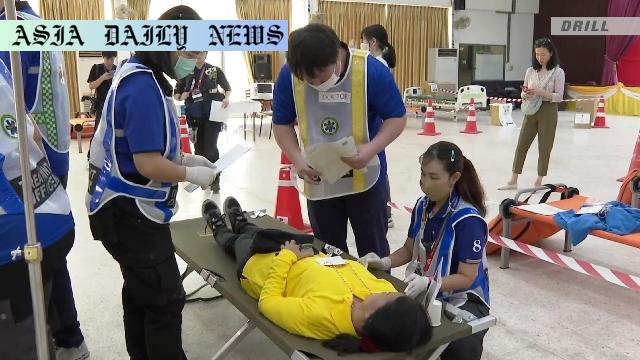Disaster rescue: Japan collaborates with ASEAN nations in Thailand to conduct drills focused on strengthening disaster readiness.

Introduction
Disaster preparedness has taken a central role in international collaboration, particularly in regions prone to natural calamities. Japan and members of the Association of Southeast Asian Nations (ASEAN) recently demonstrated their commitment to this cause by holding comprehensive disaster rescue drills in Thailand. These annual drills, initiated eight years ago after the devastating 2004 Indian Ocean tsunami, aim to bolster regional response capabilities in the face of potential disasters such as flooding and mega-earthquakes.
The Significance of the 2004 Indian Ocean Tsunami
The 2004 Indian Ocean tsunami was a turning point in the global approach to disaster management. Claiming more than 220,000 lives and leaving a trail of destruction, the tragedy underscored the urgent need for consistent and effective disaster preparedness. For Japan and ASEAN nations, the tsunami serves as a stark reminder of what’s at stake during natural calamities. By facilitating annual drills since 2015, these countries are not only honoring the lessons of the past but also working to protect their people in the future.
Details of the 2023 Disaster Rescue Drills
Taking place in Bangkok and two other strategic locations, the 2023 edition of the disaster rescue drills engaged more than 300 participants, including medical experts, local rescue teams, and military personnel. A central feature of the drills was a simulated scenario where the Chao Phraya River, a vital waterway in central Bangkok, had overflowed.
Participants worked together to set up a makeshift hospital, focusing on strategies for triaging patients based on medical urgency. The exercise also included demonstrations on emergency airlifting procedures using military helicopters, highlighting the interconnectedness of ground and air rescue operations in disaster scenarios.
Japan’s Contribution to ASEAN Disaster Preparedness
Japan’s role as a key partner in this international initiative cannot be overstated. Through the Japan International Cooperation Agency (JICA), the country has consistently emphasized the importance of regular drills to improve disaster medical treatment and foster international cooperation. The Japanese Disaster Medical Assistance Team (DMAT) actively participated, recognizing that their expertise might one day be necessary if a mega earthquake were to hit Japan.
JICA and DMAT’s involvement underscores a critical principle: effective disaster response requires not just national preparedness but also regional partnerships. These exercises enable Japan and ASEAN countries to share knowledge, build trust, and streamline their collective efforts.
Building International Cooperation
The drills also serve as a platform for enhancing communication and cooperation among participating countries. In a major disaster, quick and clear information sharing can make the difference between life and death. By practicing together, Japan and ASEAN nations are breaking down barriers, establishing protocols, and ensuring that their teams can collaborate seamlessly under pressure.
Long-Term Goals and Future Plans
With eight years of experience, these disaster rescue drills have grown into a sophisticated training program that addresses various types of emergencies. Although flooding is the primary focus, future exercises are expected to incorporate other disaster scenarios, such as typhoons, earthquakes, and even pandemics. The long-term goal is not only to prepare for immediate relief efforts but also to develop sustainable strategies for rebuilding affected communities.
Looking ahead, Japan and ASEAN countries plan to continue these drills, expanding their scope while incorporating insights from past disasters. As climate change triggers more extreme weather events, the need for international cooperation in disaster management becomes increasingly critical.
Conclusion
The disaster rescue drills between Japan and ASEAN countries represent a monumental step in fostering international solidarity against natural calamities. By blending practice with innovation and collaboration, these nations are paving the way for a safer, more prepared future. As other countries watch and learn from these efforts, the global community inches closer to a world where the devastating impact of disasters can be significantly mitigated.
Commentary
Collaboration in Action
The disaster rescue drills between Japan and ASEAN countries are a prime example of meaningful international collaboration. Natural disasters do not respect borders, and neither should our efforts to combat them. By coming together and conducting these practical exercises, Japan and ASEAN are making a strong statement: preparedness is better achieved together. This initiative highlights the importance of pooling resources, knowledge, and expertise to achieve a common goal.
Lessons for the Global Community
The vision behind these drills also offers a powerful lesson for the global community. The reality of climate change brings with it increased natural disasters, from tsunamis to hurricanes. What Japan and ASEAN are doing is setting a benchmark for how nations, despite their differences, can unite to tackle shared challenges. It is inspiring to witness so many countries prioritize not only their own citizens but also their neighbors’ welfare.
A Focus on Innovation and Humanity
Perhaps one of the most striking components of these drills is their innovative approach. Simulating real-life scenarios like airlifting patients during river flooding ensures that participants understand the complexities of emergency responses. Beyond strategy and logistics, these drills are a reminder of the profound human element involved. Whether it’s prioritizing medical treatment or coordinating evacuations, the ultimate goal remains the protection and preservation of human lives.
The Path Ahead
As these drills continue in the coming years, it will be interesting to see how they evolve and adapt to emerging challenges. With climate-related disasters on the rise, initiatives like these are more crucial than ever. As global citizens, we all have a stake in how prepared our world is for future calamities. Japan and ASEAN have taken a bold step forward, and it’s our hope that others follow their lead.


